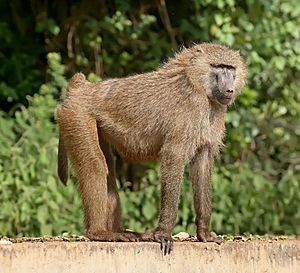Old World monkey facts for kids
Quick facts for kids Old World monkeysTemporal range: Fossil range Oligocene to Recent
|
|
|---|---|
 |
|
| Olive baboon (Papio anubis) | |
| Scientific classification | |
| Kingdom: | |
| Class: | |
| Order: | |
| Suborder: | |
| Infraorder: | |
| Parvorder: | |
| Superfamily: |
Cercopithecoidea
|
| Family: |
Cercopithecidae
Gray 1821.
|
| Subfamilies | |
|
Cercopithecinae – 12 genera |
|
The Old World monkeys are a special group of primates. Today, you can find them living in Africa and Asia. They are also known by their scientific family name, Cercopithecidae.
These monkeys live in many different places. You can find them in hot, wet rain forests and open savannas. They also live in shrublands and high mountains. Long ago, their fossils show they lived in Europe too. Even today, a group of monkeys lives freely in Gibraltar, Europe. Many monkeys you might know, like baboons and macaques, are Old World monkeys.
Contents
What Makes Old World Monkeys Special?
Old World monkeys come in different sizes. They can be medium to large. Some, like the Colobus monkey, spend most of their time in trees. Others, like baboons, live mostly on the ground.
The smallest Old World monkey is the talapoin. It is about 34 to 37 centimeters long. It weighs between 0.7 and 1.3 kilograms. The biggest is the male mandrill. It can be around 70 centimeters long. It can weigh up to 50 kilograms! Female mandrills are much smaller.
How Are They Different from Apes and Other Monkeys?
Old World monkeys are different from apes. Most Old World monkeys have tails. The name of their family, Cercopithecidae, even means "tailed ape." Apes, like gorillas or chimpanzees, do not have tails.
They are also different from New World monkeys. New World monkeys live in Central and South America. Their tails can grab onto things, like branches. This is called a prehensile tail. Old World monkeys have tails, but their tails cannot grab things.
Old World Monkey Social Life
Old World monkeys live in groups called troops. In most species, daughters stay with their mothers for their whole lives. This means the main social group is often led by the dominant female. This is called a matrilineal troop.
When young males grow up, they usually leave their birth group. They then look for a new troop to join. In some species, only one adult male lives with each group. This male will chase away any other rival males. But in other species, males are more friendly. They can form relationships with other males in the group.
The size of these monkey groups can change a lot. It depends on how much food is available. It also depends on other resources they need to survive.
Related pages
List of Old World monkey species
Images for kids
-
A male rhesus macaque (Macaca mulatta)
-
Young collared mangabey (Cercocebus torquatus).
-
Nilgiri langur (Trachypithecus johnii)
See also
 In Spanish: Monos del viejo mundo para niños
In Spanish: Monos del viejo mundo para niños






